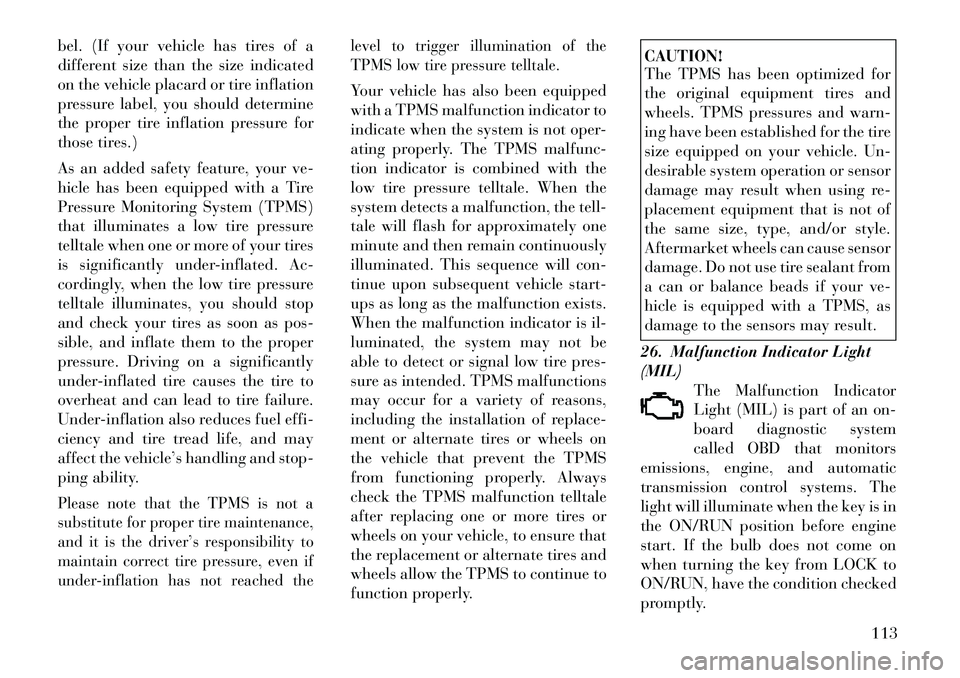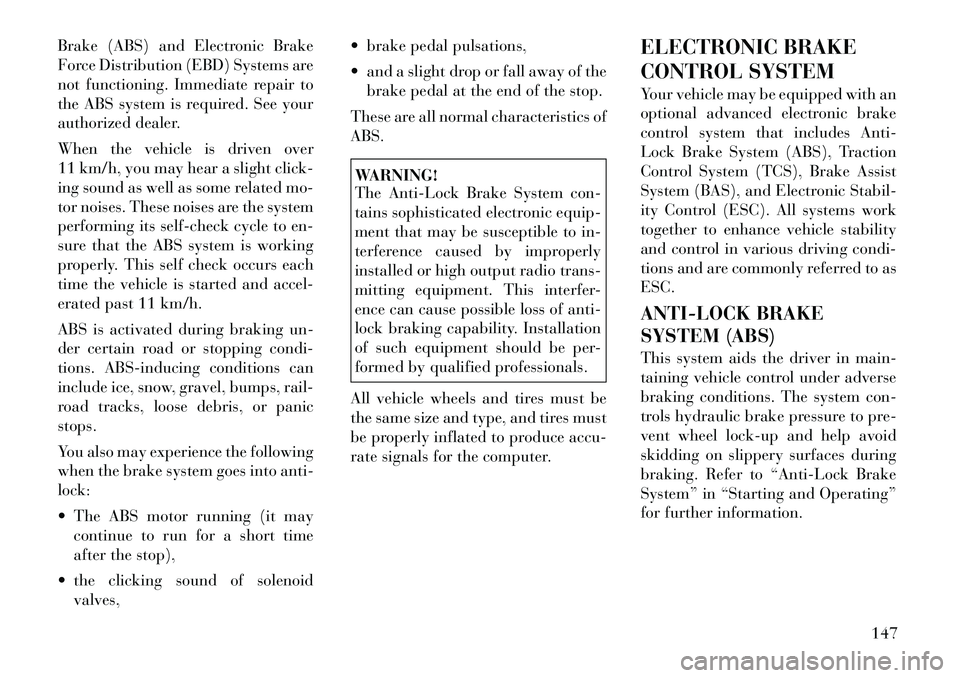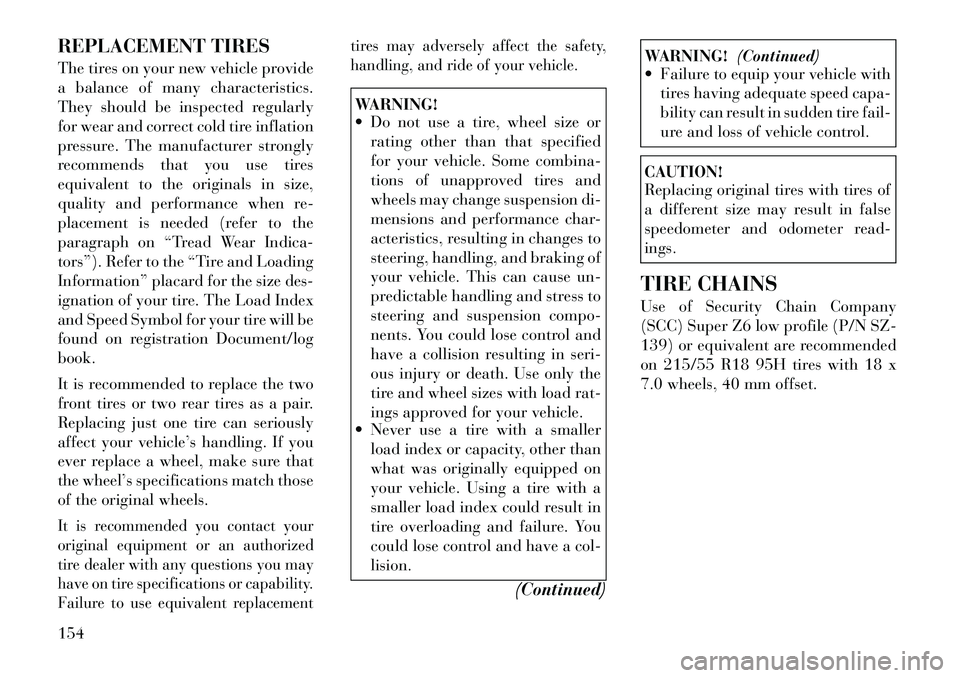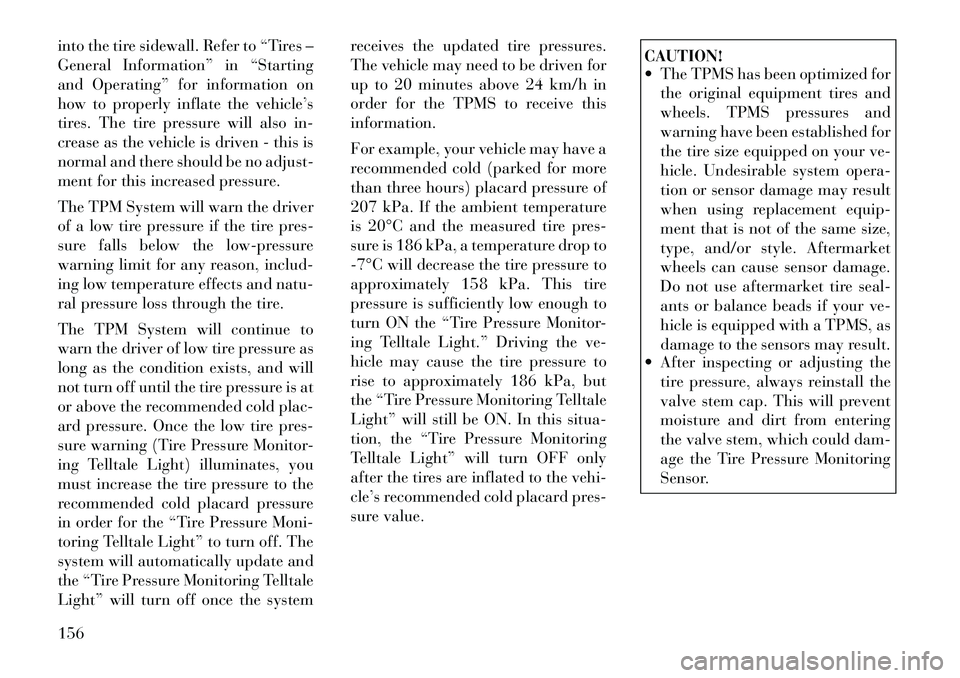tire size Lancia Flavia 2012 Owner handbook (in English)
[x] Cancel search | Manufacturer: LANCIA, Model Year: 2012, Model line: Flavia, Model: Lancia Flavia 2012Pages: 233, PDF Size: 2.61 MB
Page 120 of 233

bel. (If your vehicle has tires of a
different size than the size indicated
on the vehicle placard or tire inflation
pressure label, you should determine
the proper tire inflation pressure for
those tires.)
As an added safety feature, your ve-
hicle has been equipped with a Tire
Pressure Monitoring System (TPMS)
that illuminates a low tire pressure
telltale when one or more of your tires
is significantly under-inflated. Ac-
cordingly, when the low tire pressure
telltale illuminates, you should stop
and check your tires as soon as pos-
sible, and inflate them to the proper
pressure. Driving on a significantly
under-inflated tire causes the tire to
overheat and can lead to tire failure.
Under-inflation also reduces fuel effi-
ciency and tire tread life, and may
affect the vehicle’s handling and stop-
ping ability.Please note that the TPMS is not a
substitute for proper tire maintenance,
and it is the driver’s responsibility to
maintain correct tire pressure, even if
under-inflation has not reached thelevel to trigger illumination of the
TPMS low tire pressure telltale.
Your vehicle has also been equipped
with a TPMS malfunction indicator to
indicate when the system is not oper-
ating properly. The TPMS malfunc-
tion indicator is combined with the
low tire pressure telltale. When the
system detects a malfunction, the tell-
tale will flash for approximately one
minute and then remain continuously
illuminated. This sequence will con-
tinue upon subsequent vehicle start-
ups as long as the malfunction exists.
When the malfunction indicator is il-
luminated, the system may not be
able to detect or signal low tire pres-
sure as intended. TPMS malfunctions
may occur for a variety of reasons,
including the installation of replace-
ment or alternate tires or wheels on
the vehicle that prevent the TPMS
from functioning properly. Always
check the TPMS malfunction telltale
after replacing one or more tires or
wheels on your vehicle, to ensure that
the replacement or alternate tires and
wheels allow the TPMS to continue to
function properly.
CAUTION!
The TPMS has been optimized for
the original equipment tires and
wheels. TPMS pressures and warn-
ing have been established for the tire
size equipped on your vehicle. Un-
desirable system operation or sensor
damage may result when using re-
placement equipment that is not of
the same size, type, and/or style.
Aftermarket wheels can cause sensor
damage. Do not use tire sealant from
a can or balance beads if your ve-
hicle is equipped with a TPMS, as
damage to the sensors may result.
26. Malfunction Indicator Light
(MIL) The Malfunction Indicator
Light (MIL) is part of an on-
board diagnostic system
called OBD that monitors
emissions, engine, and automatic
transmission control systems. The
light will illuminate when the key is in
the ON/RUN position before engine
start. If the bulb does not come on
when turning the key from LOCK to
ON/RUN, have the condition checked
promptly.
113
Page 154 of 233

Brake (ABS) and Electronic Brake
Force Distribution (EBD) Systems are
not functioning. Immediate repair to
the ABS system is required. See your
authorized dealer.
When the vehicle is driven over
11 km/h, you may hear a slight click-
ing sound as well as some related mo-
tor noises. These noises are the system
performing its self-check cycle to en-
sure that the ABS system is working
properly. This self check occurs each
time the vehicle is started and accel-
erated past 11 km/h.
ABS is activated during braking un-
der certain road or stopping condi-
tions. ABS-inducing conditions can
include ice, snow, gravel, bumps, rail-
road tracks, loose debris, or panic
stops.
You also may experience the following
when the brake system goes into anti-
lock:
The ABS motor running (it maycontinue to run for a short time
after the stop),
the clicking sound of solenoid valves, brake pedal pulsations,
and a slight drop or fall away of the
brake pedal at the end of the stop.
These are all normal characteristics of
ABS.
WARNING!
The Anti-Lock Brake System con-
tains sophisticated electronic equip-
ment that may be susceptible to in-
terference caused by improperly
installed or high output radio trans-
mitting equipment. This interfer-
ence can cause possible loss of anti-
lock braking capability. Installation
of such equipment should be per-
formed by qualified professionals.
All vehicle wheels and tires must be
the same size and type, and tires must
be properly inflated to produce accu-
rate signals for the computer. ELECTRONIC BRAKE
CONTROL SYSTEM
Your vehicle may be equipped with an
optional advanced electronic brake
control system that includes Anti-
Lock Brake System (ABS), Traction
Control System (TCS), Brake Assist
System (BAS), and Electronic Stabil-
ity Control (ESC). All systems work
together to enhance vehicle stability
and control in various driving condi-
tions and are commonly referred to as
ESC.
ANTI-LOCK BRAKE
SYSTEM (ABS)
This system aids the driver in main-
taining vehicle control under adverse
braking conditions. The system con-
trols hydraulic brake pressure to pre-
vent wheel lock-up and help avoid
skidding on slippery surfaces during
braking. Refer to “Anti-Lock Brake
System” in “Starting and Operating”
for further information.
147
Page 161 of 233

REPLACEMENT TIRES
The tires on your new vehicle provide
a balance of many characteristics.
They should be inspected regularly
for wear and correct cold tire inflation
pressure. The manufacturer strongly
recommends that you use tires
equivalent to the originals in size,
quality and performance when re-
placement is needed (refer to the
paragraph on “Tread Wear Indica-
tors”). Refer to the “Tire and Loading
Information” placard for the size des-
ignation of your tire. The Load Index
and Speed Symbol for your tire will be
found on registration Document/log
book.
It is recommended to replace the two
front tires or two rear tires as a pair.
Replacing just one tire can seriously
affect your vehicle’s handling. If you
ever replace a wheel, make sure that
the wheel’s specifications match those
of the original wheels.It is recommended you contact your
original equipment or an authorized
tire dealer with any questions you may
have on tire specifications or capability.
Failure to use equivalent replacementtires may adversely affect the safety,
handling, and ride of your vehicle.
WARNING!
Do not use a tire, wheel size or
rating other than that specified
for your vehicle. Some combina-
tions of unapproved tires and
wheels may change suspension di-
mensions and performance char-
acteristics, resulting in changes to
steering, handling, and braking of
your vehicle. This can cause un-
predictable handling and stress to
steering and suspension compo-
nents. You could lose control and
have a collision resulting in seri-
ous injury or death. Use only the
tire and wheel sizes with load rat-
ings approved for your vehicle.
Never use a tire with a smaller
load index or capacity, other than
what was originally equipped on
your vehicle. Using a tire with a
smaller load index could result in
tire overloading and failure. You
could lose control and have a col-
lision.
(Continued)
WARNING!(Continued)
Failure to equip your vehicle with
tires having adequate speed capa-
bility can result in sudden tire fail-
ure and loss of vehicle control.CAUTION!
Replacing original tires with tires of
a different size may result in false
speedometer and odometer read-
ings.
TIRE CHAINS
Use of Security Chain Company
(SCC) Super Z6 low profile (P/N SZ-
139) or equivalent are recommended
on 215/55 R18 95H tires with 18 x
7.0 wheels, 40 mm offset.
154
Page 163 of 233

into the tire sidewall. Refer to “Tires –
General Information” in “Starting
and Operating” for information on
how to properly inflate the vehicle’s
tires. The tire pressure will also in-
crease as the vehicle is driven - this is
normal and there should be no adjust-
ment for this increased pressure.
The TPM System will warn the driver
of a low tire pressure if the tire pres-
sure falls below the low-pressure
warning limit for any reason, includ-
ing low temperature effects and natu-
ral pressure loss through the tire.
The TPM System will continue to
warn the driver of low tire pressure as
long as the condition exists, and will
not turn off until the tire pressure is at
or above the recommended cold plac-
ard pressure. Once the low tire pres-
sure warning (Tire Pressure Monitor-
ing Telltale Light) illuminates, you
must increase the tire pressure to the
recommended cold placard pressure
in order for the “Tire Pressure Moni-
toring Telltale Light” to turn off. The
system will automatically update and
the “Tire Pressure Monitoring Telltale
Light” will turn off once the systemreceives the updated tire pressures.
The vehicle may need to be driven for
up to 20 minutes above 24 km/h in
order for the TPMS to receive this
information.
For example, your vehicle may have a
recommended cold (parked for more
than three hours) placard pressure of
207 kPa. If the ambient temperature
is 20°C and the measured tire pres-
sure is 186 kPa, a temperature drop to
7°C will decrease the tire pressure to
approximately 158 kPa. This tire
pressure is sufficiently low enough to
turn ON the “Tire Pressure Monitor-
ing Telltale Light.” Driving the ve-
hicle may cause the tire pressure to
rise to approximately 186 kPa, but
the “Tire Pressure Monitoring Telltale
Light” will still be ON. In this situa-
tion, the “Tire Pressure Monitoring
Telltale Light” will turn OFF only
after the tires are inflated to the vehi-
cle’s recommended cold placard pres-
sure value.
CAUTION!
The TPMS has been optimized for
the original equipment tires and
wheels. TPMS pressures and
warning have been established for
the tire size equipped on your ve-
hicle. Undesirable system opera-
tion or sensor damage may result
when using replacement equip-
ment that is not of the same size,
type, and/or style. Aftermarket
wheels can cause sensor damage.
Do not use aftermarket tire seal-
ants or balance beads if your ve-
hicle is equipped with a TPMS, as
damage to the sensors may result.
After inspecting or adjusting the
tire pressure, always reinstall the
valve stem cap. This will prevent
moisture and dirt from entering
the valve stem, which could dam-
age the Tire Pressure Monitoring
Sensor.
156